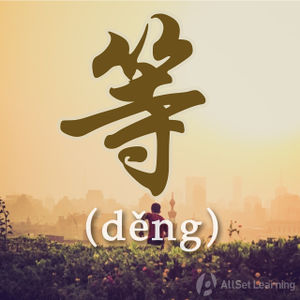Difference between revisions of "Non-exhaustive lists with "dengdeng""
m (Text replace - "{{Grammar Box}}" to "{{Grammar Box}}{{#seo:keywords={{SEO Keywords}}}} ") |
m (Text replace - "{{#seo:keywords={{SEO Keywords}}}}" to " ") |
||
| Line 1: | Line 1: | ||
| − | {{Grammar Box | + | {{Grammar Box}} |
Revision as of 04:33, 25 November 2013
-
Level
-
Similar to
-
Used for
-
Keywords
等等 (děng děng), or simply 等, has the same meaning as “and so on” or “etc.” in English. Both are placed after a series of items (the list of which generally exceeds two items).
Structure
The basic structure is easy. Just make a list of things, and add 等 or 等等 to the end of the list. It's the same as in English when we use "etc." at the end of a list.
A1,A2...等/等等
Examples
- 我 喜欢 看 书、逛 街、睡觉 等。I like to read books, window-shop, sleep etc.
- 西瓜、菠萝、苹果、葡萄 等等,都 是 我 喜欢 的 水果。Watermelons, pineapples, apples, grapes and so on are all the fruits that I like.
- 上海、北京、深圳、香港 等,我 都 去 过。Shanghai, Beijing, Shenzhen, Hong Kong etc., I have all been to.
- Jackie Chen、Jet Li、Bruce Li等都是中国有名的功夫明星。Jackie Chen, Jet Li, Bruce Li, etc. are all famous Chinese martial arts stars.
- 长城、故宫、颐和园等地方都是北京著名的景点。The Great Wall, the Summer Museum, the Summer Palace, etc. are all famous Beijing scenic spots.
- 我教过很多外国学生,美国人、英国人、西班牙人等等。I've taught a lot of foreign students: Americans, British, Spanish, etc.
- 我的男朋友会说很多门外语,英语、法语、西班牙语等等。My boyfriend can speak many foreign languages: English, French, Spanish, etc.
- 中国的历史、文化、经济等方面我都不太了解。Chinese history, culture, economy, etc., I don't have a good understanding regarding these aspects.
- 21世纪以来,中国、印度、巴西等国家发展得都很快。From the 21st century on, China, India, Brazil and so on, are all developing very rapidly.
- 中国、印度、巴西等国家都是人口大国。China, India, Brazil and so on are all populous countries.



